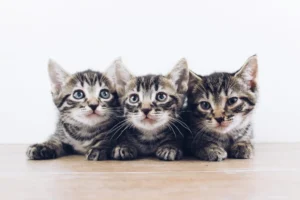Cats are known for their playful and sometimes unpredictable behavior. One common sight that cat owners may observe is their feline friend pouncing on shadows. But why do cats attack shadows?
Cats attack shadows out of instinctive predatory behavior, mistaking them for potential prey due to their quick movement and erratic patterns. This behavior is perfectly normal and can be entertaining to watch. However, there are several reasons behind this intriguing habit. Let’s explore the fascinating world of why cats attack shadows.
Natural Instincts
Cats attacking shadows may seem like a strange and puzzling behavior, but it all goes back to their innate hunting instincts. Cats are natural-born predators, and anything that moves quickly or unpredictably can set off their hunting mode. When they see a shadow moving across the floor or the wall, it triggers their primal urge to pounce and capture their prey. It’s like a built-in reflex that kicks in without a second thought.
Additionally, shadows mimic the movements of small animals like bugs or birds, making them enticing targets for our feline friends. Even though we may know that it’s just a play of light and shadow, cats see it as a potential meal or a fun challenge to chase down. So, next time you catch your cat going after a shadow, remember that it’s simply their natural instincts at play.
Playful Behavior
Let’s not forget that cats are not just fierce hunters, but they are also playful creatures at heart. Chasing shadows can be a form of entertainment and exercise for cats. It gives them a chance to practice their hunting skills in a safe and controlled environment. Plus, it can help them burn off excess energy and stay mentally stimulated.
Next time you notice your cat engaging in shadow play, try to see it as a constructive outlet for their playful nature. Providing interactive toys and engaging playtime can help redirect their energy and keep them from fixating on shadows. Remember, a happy cat is a well-exercised cat! So, embrace their playful antics and join in on the fun.
Bonus Insight: Some cats may attack shadows more frequently during certain times of the day, like dusk or dawn. This is because these low-light conditions make shadows more pronounced and engaging for them. So, if you notice your cat being extra playful with shadows during these times, it’s perfectly normal behavior.
Environmental Factors
When you notice your cat attacking shadows, consider the impact of environmental factors in your home. Lighting plays a crucial role in how shadows form and move around your space, catching your cat’s attention. Bright lighting can create more defined shadows that seem enticing to your feline friend, sparking their hunting instincts. On the other hand, dim lighting can lead to more mysterious and unpredictable shadows, challenging your cat to pounce and play. By adjusting the lighting in your home, you can help reduce your cat’s interest in shadows and redirect their energy towards more appropriate playthings.
Stimulating the Senses
Do you ever wonder why cats seem so captivated by chasing shadows? This behavior can actually provide mental and physical stimulation for your furry companion. When your cat sees a shadow moving across the floor or wall, it triggers their instinctual hunting drive, engaging their senses and keeping them on their toes. Chasing shadows can offer a form of entertainment and exercise for your cat, helping to keep them mentally sharp and physically active. To further stimulate your cat’s senses and provide them with engaging play opportunities, consider interactive toys that mimic the movements of shadows. These toys can keep your cat entertained and satisfied while minimizing their shadow-chasing tendencies.
Potential Dangers
When cats attack shadows, it may seem harmless, but there are potential dangers to consider. Obsessive behavior in constantly chasing shadows could indicate underlying stress or anxiety in your feline friend, leading to health issues if left unchecked. It’s crucial to monitor this behavior and consult a vet if it escalates.
Redirected Aggression
In multi-cat households, redirected aggression might be a key factor in why cats attack shadows. When a cat becomes agitated or feels threatened by another cat, they may redirect their frustration towards something else, like shadows. Providing ample vertical space, hiding spots, and individual attention can help reduce instances of redirected aggression among your cats.
Unique Insight: To help minimize redirected aggression, create a calming environment with separate eating areas, litter boxes, and cozy resting spots for each cat. This can help reduce tension and prevent shadow-chasing behavior.
Remember, understanding why cats attack shadows is essential to promoting their well-being and creating a harmonious home environment. By addressing potential dangers and redirecting aggression positively, you can help your feline companions lead happy, stress-free lives.
Preventive Measures
If your cat has a habit of pouncing on shadows, there are a few strategies you can try to help curb this behavior. First, ensure your cat is getting enough mental and physical stimulation through playtime and interactive toys. Engaging your feline friend in regular exercise can help reduce their desire to chase shadows. Additionally, consider providing designated play areas with ample natural light to minimize shadow-induced antics. If the behavior persists, consult with a vet to rule out any underlying health issues that may be causing your cat’s shadow-chasing tendencies.
Fun Facts about Cat Behavior
Did you know that cats’ predatory instincts play a significant role in their fascination with shadows? Instinctually, cats are wired to seek out prey and pounce on moving objects, whether real or perceived. This behavior is part of their hunting nature, honed through generations of evolution. When your cat chases shadows, it’s tapping into that primal urge to stalk and capture elusive targets. So, the next time you catch your kitty leaping at shadows, remember it’s just their inner hunter shining through!
Additional Unique Insight: Laser Pointer Dangers
While using a laser pointer can be a fun way to engage your cat’s hunting instincts, it’s essential to be cautious. Cats can become frustrated when unable to physically catch the elusive dot, leading to increased stress and potential behavior issues. To prevent this, always end a laser play session with a tangible toy or treat for your cat to “capture,” satisfying their predatory drive. By combining laser play with a tangible reward, you can ensure your cat has a fulfilling and safe play experience.
Alex, a passionate animal lover, has experience in training and understanding animal behavior. As a proud pet parent to two dogs and three cats, he founded AnimalReport.net to share insights from animal experts and expand his knowledge of the animal kingdom.









